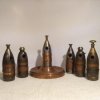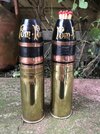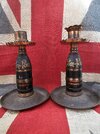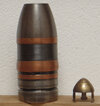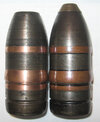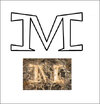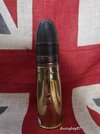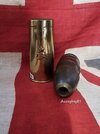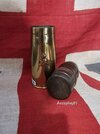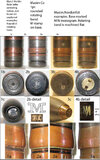British Ordnance Collectors Network
You are using an out of date browser. It may not display this or other websites correctly.
You should upgrade or use an alternative browser.
You should upgrade or use an alternative browser.
Unknown 37mm projectile
- Thread starter Buster
- Start date
mach1bang
Well-Known Member
A few more to add to the fun.....View attachment 148206
But these all look German,certainly not British.
Tim.
They likely are, there were a lot of German examples made with real projectiles. German projectiles have a wider upper band
than British projectiles and have different markings on the base etc. I think the oldest are the German facsimile types shown
previously. I have seen one German set of two, one the trimmer and the other with a wick to pass around to light the cigars.
than British projectiles and have different markings on the base etc. I think the oldest are the German facsimile types shown
previously. I have seen one German set of two, one the trimmer and the other with a wick to pass around to light the cigars.
Thank you Tucco looks good to me.Trench Art Match holders with a machined striker .
auzzyboy80
Member
Neville I have a pair of candle holders 1 also has a registered number stamped in to the drive bandI agree the expense would seem prohibitive. Interestingly I have also seen this design number on candlesticks incorporating 1-pounder projectiles (facsimile or real?). In addition, I have a couple of projectiles on plinths which have the impressed lettering: "A FACSIMILE 1 POUNDER POM-POM EXPLOSIVE SHELL". These have the registered design number 355754, and also look and feel like the real thing. But, then, why specifically state that they are facsimiles. Indeed, is it even legal to add a registered design number to something that has been manufactured by another company?
View attachment 148145
Attachments
This was wrong of course !What this is, is ~
A standard Hotchkiss PD projectile with the thin wide brass band removed. This exposes the underlying ribs. 'Then the British pattern of centering and rotating 1 Pr. band has been pressed on to bring it up to a "Modern" standard. I think this is a Norwegian practice projectile, though I stand to be corrected on that by greater minds. The filling is possibly for weight and there was most likely a press fit nose plug at one time.
Of course I don't have one and would be happy to make a very worth while trade for same~:tinysmile_kiss_t4:
The cigar trimmer is likely a German product. The copper bands may be thin metal over a cast shape, it is not likely a real projectile but a total facimilie , the calibre maybe undersized as well.Here are two more projectiles that were made/modified for the souvenir trade. The first example has impressed lettering on the brass plinth: "A FACSIMILE 1 POUNDER POM-POM EXPLOSIVE SHELL" "REGD NO 355754" (dating it to the second half of 1900). As with the examples above, I am unable to differentiate this from a genuine round, once again suggesting the use of surplussed stock. I also have one of these with a cut-away, revealing a facsimile explosive charge. The cigar-cutter, on the other hand, is unlike any other 1-pounder I have come across. The drive bands do not look very aerodynamic to me! However, my field is exclusively Anglo-Boer War, so I know little about the form of these pieces before 1899 and after 1902.
Regarding the Marriott examples above, does anyone know whether the registered design records at Kew have written descriptions as well as drawings? If so, this might be the only way of finding out the purpose of William Ernest Capner Pinchbeck's design(s). I still find it very odd that these were being modified by a bicycle manufacturer.
Also, is it relevant that the example with the cap lacks the plaster infill? In other words, could it have had a different use to the examples with the shallower 7/8 inch deep cavities?
View attachment 148191 View attachment 148192
I like the idea of a match holder ( it makes so much sense that it's obvious which is why I didn't think of it !), the bottom plaster filled to support the matches and keep them from dissapearing. The only modificstion are the stricker grooves and the enlarging of the fuze hole. There are also brass caps for these. But if the rotating band is rounded not flat and that indidcates very early manufacture.
Always check the base of these for a Letter M stamp as that would indicate Maxim co. prior to Nordenfelt.
The band on these is generally called a Nordenfelt band, but I think it is in reality a Maxim design, prior to Nordenfelt.
Always check the base of these for a Letter M stamp as that would indicate Maxim co. prior to Nordenfelt.
The band on these is generally called a Nordenfelt band, but I think it is in reality a Maxim design, prior to Nordenfelt.
Attachments
Last edited:
auzzyboy80
Member
I like the idea of a match holder, the bottom plaster filled to support the matches and keep them from dissapearing. But
there are also brass caps for these. But the rotating band is rounded not flat and that indidcates very early manufacture.
Always check the base of these for a Letter M stamp as that would indicate Maxim co prior to Nordenfelt.
Gspragge what do you make of this one? British in design. But total odd at the top. It's like a brass collar, when I poke something down the side after about half in down I can feel the threads. There isn't any plaster to hold matches up so in not sureI like the idea of a match holder, the bottom plaster filled to support the matches and keep them from dissapearing. But
there are also brass caps for these. But the rotating band is rounded not flat and that indidcates very early manufacture.
Always check the base of these for a Letter M stamp as that would indicate Maxim co prior to Nordenfelt.
Attachments
It should unscrew, but getting a grip on it will be difficult. Though one could I supose crazy glue a rod into it which could be removed by heating
it later if that worked. It could be a cut down fuze body threaded to hold something else now mising. It looks like and likely is a regular 1pr.
Not related to the other ones. The methods used to toture these is endless ~
it later if that worked. It could be a cut down fuze body threaded to hold something else now mising. It looks like and likely is a regular 1pr.
Not related to the other ones. The methods used to toture these is endless ~
auzzyboy80
Member
I have attempted to try and get it out but didn't manage it. I don't think there is anything to gain from getting it out and possibly damaging it so I'll just leave it.It should unscrew, but getting a grip on it will be difficult. Though one could I supose crazy glue a rod into it which could be removed by heating
it later if that worked. It could be a cut down fuze body threaded to hold something else now mising. It looks like and likely is a regular 1pr.
Not related to the other ones. The methods used to toture these is endless ~
The M marked projectile came with a candle top like yours with the fancy bit missing off of the top. It had a resgistration number on it also.Neville I have a pair of candle holders 1 also has a registered number stamped in to the drive band
When I found the M on the base I moved the candle piece to an unmarked projectile and put it on a finely engraved Boer war case. The M marked projectile
with a practice (solid) fuze are the beginnng of the Maxim 1pr series here. I hope that you and any one else can check the bases of your illuminating 1prs and match holders to find another M marked projectile (look carefully it may be partially obscured by paint or what ever finish was applied). Nothings worse than having the only one so far ! These are the best candidates for finding another one.
I had heard that the fancy POM POM art work was post ww2 by one individual and not circa 1900, but I don't have that reference now.
I found this image showing details of these early types, I've added to it a bit. Hope it helps.
I agree all you would find is an empty fuze body and not much else I expect.
Attachments
Last edited:
auzzyboy80
Member
Iv just looked and removed the paint on both mine, there is no "M" on either, there is a threaded hole dead centre to fix them to the base so possibly the "M" could have been drilled out? Either way we will never know.The M marked projectile came with a candle top like yours with the fancy bit missing off of the top. It had a resgistration number on it also.
When I found the M on the base I moved the candle piece to an unmarked projectile and put it on a finely engraved Boer war case. The M marked projectile
with a practice (solid) fuze are the beginnng of the Maxim 1pr series here. I hope that you and any one else can check the bases of your illuminating 1prs and match holders to find another M marked projectile (look carefully it may be partially obscured by paint or what ever finish was applied). Nothings worse than having the only one so far ! These are the best candidates for finding another one.
I had heard that the fancy POM POM art work was post ww2 by one individual and not circa 1900, but I don't have that reference now.
I found this image showing details of these early types, I've added to it a bit. Hope it helps.
I agree all you would find is an empty fuze body and not much else I expect.

